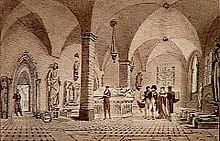Alexandre Lenoir

Marie Alexandre Lenoir (born December 27, 1761 in Paris , † June 11, 1839 there ) was a French archaeologist . As a passionate autodidact, he became a connoisseur of French medieval art and tried during the French Revolution to save famous monuments such as those in Saint-Denis and Sainte-Geneviève from destruction. His role as an art historian and archaeologist as well as a curator and founder of the Musée des Monuments français is not without controversy.
Life
Alexandre Lenoir studied painting with Gabriel François Doyen . In 1789 he was appointed to the Commission des Arts , which, under the impression of the destruction of historical monuments by vandalism and neglect during the beginning of the French Revolution, was supposed to try to preserve important works of art. The Hôtel des Nesle and the former convent of the Petits Augustins, whose director Lenoir was appointed in 1791 at the instigation of Doyen and the mayor of Paris, were designated as depots for the rescued works of art. After the Louvre opened in 1793 as the new Musée Central des Arts , which only presented classical and contemporary art, Lenoir was its harshest critic and began to campaign for the establishment of its own museum for medieval art.
During the radicalizing revolution, he continued to campaign for the recovery of historical evidence, such as some tombs of the French kings from Saint-Denis but also works of art from all over France, although this put himself in danger. In 1796 he finally succeeded in opening the Musée des Antiquités et Monuments Français ( Musée des Monuments français for short ) in the Petits Augustins . It was the first public museum that followed a strictly chronological order in its presentation and only exhibited works of art from the Middle Ages and the Renaissance in France. The arrangement of the objects in appropriately designed "epoch rooms" was particularly unusual and was to influence many museum concepts of the 19th century.
Since the scientific standards and understanding of medieval art began to change in the general public after 1800, Lenoir's (sometimes crude) conservation methods met with increasing criticism, as in Quatremère de Quincy's Considérations morales . After the fall of Napoleon and the return of stolen works of art from the Louvre, Louis XVIII. to have many of the works of art in Lenoir's museum returned to their place of origin. This prompted Lenoir to write a letter of defense in which he describes the circumstances of the vandalism during the revolution and partially perhorresziert, with which he had a great influence on the later perception of the cultural crimes during the revolution.
His wife Adélaïde, née Binart, (1771-1832) exhibited in the salon under Lenoir's name.
Meaning and criticism

Despite Lenoir's far-reaching achievement in saving art monuments all over France during the revolutionary period, he was heavily criticized and discredited. Among other things, he used his influence and had monuments that were not endangered at all, brought to his museum (such as the bones of poets) in order to create public attractions. He not only had monuments restored, but also changed, reassembled and forged in order to be able to create harmonious and atmospheric museum halls.
In 2016 the Louvre hosted an exhibition on Alexandre Lenoir curated by Geneviève Bresc-Bautier and Beatrice de Chancel-Bardelot.
Works
- Histoire des arts en France, prouvée par les monuments. Suivie d'une description chronologique des statues en marbre et en bronze, bas-reliefs et tombeaux des hommes et des femmes célèbres, rénuis au Musée impérial des monuments français. Hacquart, Paris 1810
- Recueil de portraits inedits des hommes et des femmes qui ont illustré la France sous différens règnes, dont les originaux sont conservés dans ledit musée. Paris 1809.
- Description historique et chronologique des monuments de sculpture, réunis au Musée des monuments français . Musée des monuments français, 4 volumes, Paris to V de la République [1795–1806]. Digital copy (7th ed., Auteur, Paris [an XI [1803]], 1 volume)
- Musée des monuments français: histoire de la peinture sur verre, et description des vitraux anciens et modern, pour servir à l'histoire de l'art, relativement à la France; ornée de gravures, et notamment de celles de la fable de Cupidon et Psyché, d'après les dessins de Raphael. L'Imprimerie de Guilleminet, Paris 1803.
- Musée impérial des monuments français: histoire des arts en France, et description chronologique des statues en marbre et en bronze, bas-reliefs et tombeaux des hommes et des femmes célèbres, qui sont réunis dans ce musée. Hacquart, Paris 1810.
literature
- Louis Courajod : Alexandre Lenoir, son journal et le Musée des monuments français . 3 volumes, Champion, Paris 1878–1887.
Web links
- Dictionary of Art Historians - Vita Alexandre Lenoirs
- Alexandre Lenoir at arthistoricum.net - digitized works in the themed portal "History of Art History"
Individual evidence
- ↑ Ulrich Rehm: A place to sleep in history: Alexandre Lenoir's "Jardin Elysee". (PDF; 8.4 MB) In: ub.uni-heidelberg.de. 2007, accessed on May 2, 2017 (published in: Denk, Claudia; Ziesemer, John (Ed.): Der bürgerliche Tod: urban burial culture from the Enlightenment to the early 20th century , Regensburg 2007, pp. 122–131 ‹ICOMOS - Booklets of the German National Committee; 44 ›).
- ↑ Kathrin Hondl: Paris - The Louvre is reminiscent of a forgotten museum (archive). In: deutschlandfunk.de. April 17, 2016, accessed May 2, 2017 .
- ^ Jürgen König: Exhibition on Alexandre Lenoir - door opener for French art (archive). In: deutschlandfunkkultur.de. April 4, 2016, accessed May 2, 2017 .
| personal data | |
|---|---|
| SURNAME | Lenoir, Alexandre |
| ALTERNATIVE NAMES | Lenoir, Marie Alexandre (full name) |
| BRIEF DESCRIPTION | French art historian and archaeologist |
| DATE OF BIRTH | December 27, 1762 |
| PLACE OF BIRTH | Paris , France |
| DATE OF DEATH | June 11, 1839 |
| Place of death | Paris , France |
